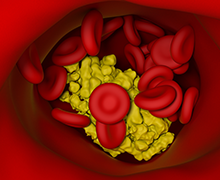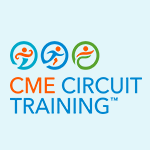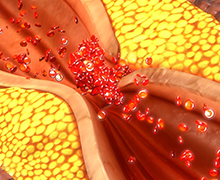Why patients with familial hypercholesterolemia are at high cardiovascular risk? Beyond LDL-C levels.
Bianconi V, Banach M, Pirro M. Trends Cardiovasc Med. 2021;31(4):205-215.
Efficacy and safety of alirocumab in adults with homozygous familial hypercholesterolemia: The ODYSSEY HoFH trial.
Blom DJ, Harada-Shiba M, Rubba P, et al. J Am Coll Cardiol. 2020;76(2):131-142.
Familial hypercholesterolemia: is it time to separate monogenic from polygenic familial hypercholesterolemia?
Brandts J, Dharmayat KI, Ray KK, Vallejo-Vaz AJ. Curr Opin Lipidol. 2020;31(3):111-118.
PCSK9 inhibition with alirocumab in pediatric patients with heterozygous familial hypercholesterolemia: the ODYSSEY KIDS study.
Daniels S, Caprio S, Chaudhari U, et al. J Clin Lipidol. 2020;14(3):322-330.
Impact of lipids on cardiovascular health: JACC Health Promotion Series.
Ference BA, Graham I, Tokgozoglu L, Catapano AL. J Am Coll Cardiol. 2018;72(23 Pt B):2980-2995.
Efficacy and safety of alirocumab in patients with heterozygous familial hypercholesterolemia and LDL-C of 160 mg/dl or higher.
Ginsberg HN, Rader DJ, Raal FJ, et al. Cardiovasc Drugs Ther. 2016;30(5):473-483.
Recognition and treatment of homozygous familial hypercholesterolemia by primary care physicians: a survey from the National Lipid Association.
Hemphill L, Goldberg A, Hovingh K, Cohen J, Karalis DG. J Gen Intern Med. 2020;35(7):2225-2227.
Prevalence of familial hypercholesterolemia among the general population and patients with atherosclerotic cardiovascular disease: a systematic review and meta-analysis.
Hu P, Dharmayat KI, Stevens CAT, et al. Circulation. 2020;141(22):1742-1759.
ODYSSEY FH I and FH II: 78 week results with alirocumab treatment in 735 patients with heterozygous familial hypercholesterolaemia.
Kastelein JJ, Ginsberg HN, Langslet G, et al. Eur Heart J. 2015;36(43):2996-3003.
Diagnostic yield and clinical utility of sequencing familial hypercholesterolemia genes in patients with severe hypercholesterolemia.
Khera AV, Won HH, Peloso GM, et al. J Am Coll Cardiol. 2016;67(22):2578-2589.
Angiopoietin-like protein 3 (ANGPTL3) inhibitors in the management of refractory hypercholesterolemia.
Kosmas CE, Bousvarou MD, Sourlas A, et al. Clin Pharmacol. 2022;14:49-59.
Treatment goals in familial hypercholesterolaemia—time to consider low-density lipoprotein-cholesterol burden.
Langslet G, Holven KB, Bogsrud MP. Eur J Prev Cardiol. 2021;29(17):2278-2280.
Prevention of atherosclerotic cardiovascular disease in children with familial hypercholesterolemia.
Peterson AL, McNeal CJ, Wilson DP. Curr Atheroscler Rep. 2021;23(10):64.
Evinacumab for homozygous familial hypercholesterolemia.
Raal FJ, Rosenson RS, Reeskamp LF, et al. N Engl J Med. 2020;383(8):711-720.
Existing and emerging therapies for the treatment of familial hypercholesterolemia.
Rosenson RS. J Lipid Res. 2021;62:100060.
Evolocumab in pediatric heterozygous familial hypercholesterolemia.
Santos RD, Ruzza A, Hovingh GK, et al. N Engl J Med. 2020;383(14):1317-1327.
Clinical Practice Guidelines
Genetic testing in dyslipidemia: a scientific statement from the National Lipid Association.
Brown EE, Sturm AC, Cuchel M, et al. J Clin Lip idol. 2020;14(4):398-413.
The agenda for familial hypercholesterolemia: a scientific statement from the American Heart Association.
Gidding SS, Champagne MA, de Ferranti SD, et al. Circulation. 2015;132(22):2167-2192.
Familial hypercholesterolemia: screening, diagnosis and management of pediatric and adult patients: clinical guidance from the National Lipid Association Expert Panel on Familial Hypercholesterolemia.
Goldberg AC, Hopkins PN, Toth PP, et al. J Clin Lipidol. 2011;5(suppl 3):S1-S8.
AHA/ACC/AACVPR/AAPA/ABC/ACPM/ADA/AGS/APhA/ASPC/NLA/PCNA Guideline on the Management of Blood Cholesterol: a report of the American College of Cardiology/American Heart Association Task Force on Clinical Practice Guidelines.
Grundy SM, Stone NJ, Bailey AL, et al. 2018 Circulation. 2019;139(25):e1046-e1081.
2017 focused update of the 2016 ACC Expert Consensus Decision Pathway on the role of non-statin therapies for LDL-cholesterol lowering in the management of atherosclerotic cardiovascular disease risk: a report of the American College of Cardiology Task Force on Expert Consensus Decision Pathways.
Lloyd-Jones DM, Morris PB, Ballantyne CM, et al J Am Coll Cardiol. 2017;70(14):1785-1822.
2019 ESC/EAS Guidelines for the management of dyslipidaemias: lipid modification to reduce cardiovascular risk. The Task Force for the management of dyslipidaemias of the European Society of Cardiology (ESC) and European Atherosclerosis Society (EAS).
Mach F, Baigent C, Catapano AL, et al. Eur Heart J. 2020;41(1):111-188.
The National Lipid Association scientific statement on coronary artery calcium scoring to guide preventive strategies for ASCVD risk reduction.
Orringer CE, Blaha MJ, Blankstein R, et al. J Clin Lipidol. 2021;15(1):33-60.
Clinical genetic testing for familial hypercholesterolemia: JACC Scientific Expert Panel.
Sturm AC, Knowles JW, Gidding SS, et al. J Am Coll Cardiol. 2018;72(6):662-680.
Patient & Caregiver Resources
American Heart Association
Family Heart Foundation
National Lipid Association


Test Your Might in Familial Hypercholesterolemia
A Self-Assessment CME Test
| Faculty: | Christopher P. Cannon, MD |
| Release: | 01/31/2023 |
| Expiration: | 01/31/2024 |


Exercising Best Practices in Familial Hypercholesterolemia
An Interactive Journey
| Faculty: | Robert S. Rosenson, MD |
| Release: | 02/28/2023 |
| Expiration: | 02/28/2024 |


Going the Distance in Familial Hypercholesterolemia
A Multimedia Case Study
| Faculty: | Ann Liebeskind, MD, FAAP, FNLA |
| Release: | 02/28/2023 |
| Expiration: | 02/28/2024 |






